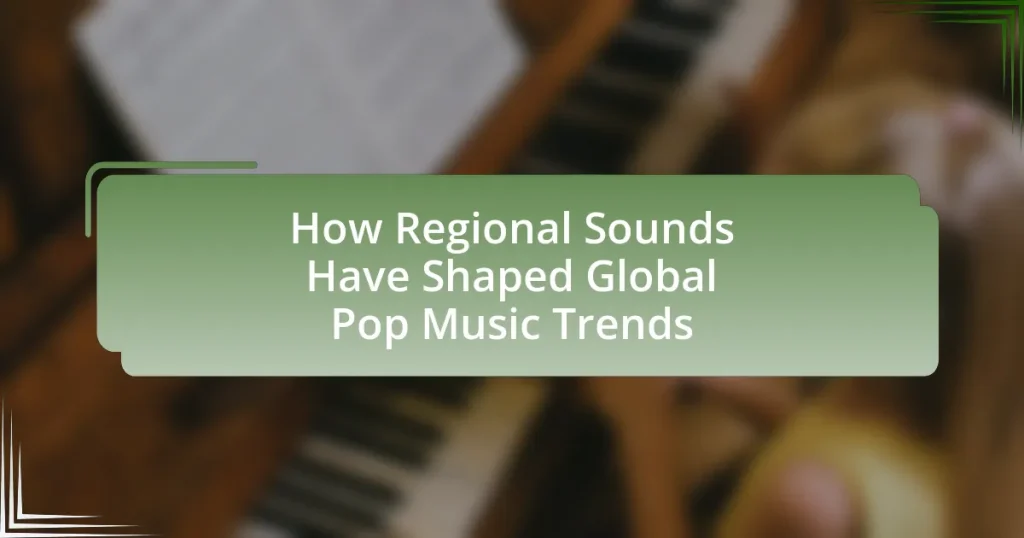The article examines how regional sounds have significantly influenced global pop music trends, highlighting the incorporation of diverse musical elements from genres such as Afrobeat, K-pop, and reggaeton. It discusses key regional sounds that have emerged, their cultural differences, and the factors contributing to their development. The role of technology and social media in facilitating the global spread of these sounds is also explored, along with notable collaborations between regional artists and global pop stars. Additionally, the article addresses future trends in the intersection of regional sounds and pop music, emphasizing the importance of cultural context and authenticity in blending influences.

How Have Regional Sounds Influenced Global Pop Music Trends?
Regional sounds have significantly influenced global pop music trends by introducing diverse musical elements and styles that resonate with wider audiences. For instance, the incorporation of Afrobeat rhythms into mainstream pop, as seen in songs by artists like Beyoncé and Drake, showcases how regional genres can shape global music. Additionally, the rise of K-pop has brought Korean musical styles and production techniques to international prominence, leading to a surge in global interest in Asian pop culture. This cross-pollination of sounds not only enriches the global music landscape but also reflects the interconnectedness of cultural expressions, as evidenced by the Billboard charts increasingly featuring artists from various regions, highlighting the impact of regional sounds on global pop music trends.
What are the key regional sounds that have emerged in pop music?
Key regional sounds that have emerged in pop music include reggaeton from Latin America, K-pop from South Korea, and Afrobeats from West Africa. Reggaeton, characterized by its rhythmic beats and catchy melodies, gained global popularity with artists like Bad Bunny and J Balvin, contributing to the genre’s mainstream success. K-pop, known for its polished production and elaborate choreography, has seen groups like BTS and BLACKPINK achieve international acclaim, significantly influencing global pop culture. Afrobeats, with its infectious rhythms and fusion of traditional African music with contemporary sounds, has been popularized by artists such as Burna Boy and Wizkid, expanding its reach beyond Africa. These regional sounds have not only shaped the music industry but also influenced fashion, dance, and social media trends worldwide.
How do these regional sounds differ from one another?
Regional sounds differ primarily in their musical scales, instrumentation, rhythms, and cultural influences. For instance, Latin American music often features syncopated rhythms and instruments like the guitar and marimba, while African music may emphasize polyrhythms and percussion instruments such as drums. Additionally, Middle Eastern sounds frequently utilize microtones and instruments like the oud, creating a distinct auditory experience. These differences are rooted in the unique cultural histories and social contexts of each region, which shape their musical expressions and contribute to the global diversity of pop music trends.
What cultural factors contribute to the development of these sounds?
Cultural factors such as historical migration patterns, local musical traditions, and social movements significantly contribute to the development of regional sounds. For instance, the blending of African rhythms with European musical forms during the transatlantic slave trade led to the creation of genres like jazz and blues in the United States. Additionally, the influence of technology, such as the rise of the internet and social media, has facilitated the global exchange of musical styles, allowing regional sounds to reach wider audiences and evolve. This interplay of cultural heritage and modern communication has shaped contemporary pop music trends, as seen in the global popularity of K-pop, which incorporates traditional Korean elements with Western pop influences.
Why is it important to study the impact of regional sounds on global pop music?
Studying the impact of regional sounds on global pop music is crucial because it reveals how diverse musical influences shape mainstream trends. Regional sounds contribute unique elements, such as rhythms, instruments, and vocal styles, which can lead to innovative genres and broaden the appeal of pop music worldwide. For instance, the incorporation of Afrobeat elements in Western pop has led to chart-topping hits, demonstrating the commercial viability of blending regional sounds. This cross-pollination not only enriches the music landscape but also fosters cultural exchange and understanding, as seen in the global success of artists like Bad Bunny, who integrates Latin sounds into pop.
How do regional sounds reflect cultural identity in pop music?
Regional sounds reflect cultural identity in pop music by incorporating local musical styles, instruments, and linguistic elements that resonate with specific communities. For instance, the use of traditional instruments like the sitar in Indian pop or the accordion in French chanson highlights cultural heritage and connects artists to their roots. Additionally, lyrics that incorporate local dialects or themes relevant to regional experiences foster a sense of belonging and authenticity. This blending of regional sounds into pop music not only preserves cultural narratives but also influences global trends, as seen in the rise of genres like reggaeton, which combines Latin rhythms with mainstream pop, thereby showcasing the cultural identity of Latin American communities on a global stage.
What role do regional sounds play in the evolution of pop music genres?
Regional sounds significantly influence the evolution of pop music genres by introducing unique rhythms, melodies, and cultural elements that enrich the genre’s diversity. For instance, the incorporation of Latin rhythms in pop music has led to the rise of reggaeton and Latin pop, which gained global popularity through artists like Shakira and Bad Bunny. Additionally, the blending of African musical traditions with Western pop has resulted in genres like Afrobeats, which have seen a surge in international recognition, exemplified by artists such as Burna Boy and Wizkid. These regional sounds not only diversify the musical landscape but also reflect cultural narratives, making pop music more relatable and appealing to a broader audience.

What Mechanisms Facilitate the Global Spread of Regional Sounds?
The mechanisms that facilitate the global spread of regional sounds include digital technology, social media platforms, and international collaborations. Digital technology allows for easy recording and distribution of music, enabling artists from various regions to share their sounds globally. Social media platforms, such as YouTube and TikTok, amplify this reach by allowing users to discover and share music from different cultures, often leading to viral trends. International collaborations between artists from different backgrounds further blend regional sounds into mainstream music, as seen in the rise of genres like reggaeton and K-pop, which incorporate diverse musical influences. These mechanisms collectively contribute to the globalization of regional sounds, reshaping pop music trends worldwide.
How do technology and media contribute to the dissemination of regional sounds?
Technology and media significantly enhance the dissemination of regional sounds by providing platforms for global access and sharing. Digital streaming services, social media, and online radio allow artists to reach international audiences, breaking geographical barriers. For instance, platforms like Spotify and YouTube have enabled regional genres, such as K-pop from South Korea and Afrobeat from Nigeria, to gain worldwide popularity, evidenced by K-pop’s rise to prominence in global charts and Afrobeat’s influence on mainstream music. Additionally, social media facilitates viral trends, allowing regional sounds to be sampled and integrated into various music styles, further amplifying their reach and impact on global pop music trends.
What platforms are most effective in promoting regional music globally?
Streaming platforms such as Spotify, Apple Music, and YouTube are the most effective in promoting regional music globally. These platforms provide extensive reach and accessibility, allowing artists to share their music with a worldwide audience. For instance, Spotify’s algorithm-driven playlists and global user base enable regional artists to gain exposure beyond their local markets, as evidenced by the rise of Latin music in mainstream charts, which saw a 25% increase in global streams from 2019 to 2020. Additionally, YouTube serves as a vital platform for music discovery, with over 2 billion logged-in monthly users, facilitating the viral spread of regional sounds through user-generated content and music videos.
How has social media changed the landscape for regional sounds in pop music?
Social media has significantly transformed the landscape for regional sounds in pop music by providing a platform for diverse musical styles to reach global audiences. This democratization of music distribution allows artists from various regions to share their unique sounds without the need for traditional gatekeepers like record labels. For instance, platforms like TikTok and Instagram have propelled regional genres, such as K-pop and Latin music, into mainstream popularity, evidenced by the global success of artists like BTS and Bad Bunny. According to a report by the International Federation of the Phonographic Industry, streaming services and social media have contributed to a 20% increase in global music consumption, highlighting the impact of these platforms on the accessibility and visibility of regional sounds.
What collaborations have emerged between regional artists and global pop stars?
Collaborations between regional artists and global pop stars have significantly influenced the music landscape, exemplified by the partnership between Bad Bunny, a Puerto Rican reggaeton artist, and J Balvin, who collaborated on the hit “I Like It” with Cardi B, blending Latin trap with mainstream hip-hop. Another notable collaboration is between Nigerian artist Burna Boy and American singer Beyoncé on the track “Ja Ara E,” featured in the “Lion King: The Gift” album, which showcases Afrobeat’s global reach. Additionally, the collaboration between Colombian singer Shakira and American artist Rihanna on “Can’t Remember to Forget You” highlights the fusion of Latin pop with global pop sensibilities. These collaborations illustrate how regional sounds are shaping and enriching global pop music trends, creating a cross-cultural exchange that resonates with diverse audiences.
How do these collaborations influence the sound and style of pop music?
Collaborations in pop music significantly influence its sound and style by blending diverse musical elements and cultural influences. For instance, when artists from different genres, such as hip-hop and reggaeton, collaborate, they create hybrid sounds that attract wider audiences and push genre boundaries. A notable example is the collaboration between Luis Fonsi and Justin Bieber on “Despacito,” which combined Latin rhythms with pop sensibilities, leading to a global hit that topped charts in multiple countries. This fusion not only enhances the sonic palette of pop music but also introduces regional sounds to mainstream audiences, thereby shaping global pop trends.
What are some notable examples of successful cross-cultural collaborations?
Notable examples of successful cross-cultural collaborations include the partnership between American rapper Jay-Z and Nigerian artist Wizkid, which resulted in the global hit “Brown Skin Girl.” This collaboration highlights the fusion of hip-hop and Afrobeats, showcasing how regional sounds can influence mainstream music. Another example is the collaboration between Colombian singer Shakira and Spanish artist Alejandro Sanz on the song “La Tortura,” which blends Latin pop with elements of flamenco, achieving international acclaim and commercial success. These collaborations demonstrate the ability of artists from different cultural backgrounds to create music that resonates globally, reflecting diverse influences and expanding the reach of regional sounds in pop music.

What Are the Future Trends in the Intersection of Regional Sounds and Global Pop Music?
Future trends in the intersection of regional sounds and global pop music will increasingly emphasize collaboration and fusion, leading to a more diverse musical landscape. As technology advances, artists from different cultural backgrounds will leverage digital platforms to blend regional sounds with mainstream pop, creating hybrid genres that appeal to global audiences. For instance, the rise of platforms like TikTok has already facilitated the viral spread of regional music styles, such as Afrobeats and K-pop, influencing mainstream pop trends. Additionally, data analytics will play a crucial role in identifying emerging regional sounds, allowing record labels to invest in diverse talent and promote cross-cultural collaborations. This trend is supported by the growing popularity of global music festivals that celebrate regional diversity, indicating a shift towards inclusivity in the music industry.
How might regional sounds continue to shape the future of pop music?
Regional sounds will continue to shape the future of pop music by influencing its rhythms, melodies, and cultural narratives. As artists increasingly draw inspiration from diverse musical traditions, genres such as reggaeton, K-pop, and Afrobeats have gained global popularity, demonstrating the impact of regional sounds on mainstream music. For instance, the rise of Latin music in the U.S. charts, with songs like “Despacito” achieving record-breaking streams, illustrates how regional influences can dominate pop trends. Additionally, platforms like TikTok facilitate the rapid dissemination of regional sounds, allowing them to reach wider audiences and integrate into pop music more seamlessly. This ongoing exchange between local and global music cultures ensures that regional sounds will remain a vital force in shaping the evolution of pop music.
What emerging regional sounds are gaining traction in the global music scene?
Emerging regional sounds gaining traction in the global music scene include Afrobeats from West Africa, K-pop from South Korea, and Latin trap from Latin America. Afrobeats has seen significant international success, with artists like Burna Boy and Wizkid topping charts worldwide, reflecting a growing appreciation for African rhythms and melodies. K-pop has exploded in popularity, with groups like BTS and BLACKPINK achieving massive global followings, showcasing the appeal of Korean pop culture. Latin trap, led by artists such as Bad Bunny and J Balvin, has also made waves, blending reggaeton with hip-hop influences, resulting in chart-topping hits that resonate across diverse audiences. These genres illustrate how regional sounds are increasingly influencing global music trends, supported by streaming platforms and social media that facilitate cross-cultural exchange.
How can artists leverage regional influences to innovate in pop music?
Artists can leverage regional influences to innovate in pop music by incorporating local musical styles, instruments, and cultural themes into their compositions. For instance, the fusion of Afrobeat rhythms with contemporary pop has led to the global success of artists like Burna Boy, who blends traditional Nigerian sounds with modern production techniques. This approach not only enriches the pop genre but also introduces diverse cultural narratives, appealing to a broader audience. The success of Latin pop, exemplified by artists like Bad Bunny, showcases how regional influences can drive innovation and reshape global music trends, as evidenced by the genre’s significant growth in streaming and chart performance worldwide.
What strategies can artists use to incorporate regional sounds into their music?
Artists can incorporate regional sounds into their music by utilizing local instruments, collaborating with regional musicians, and integrating traditional melodies and rhythms. For instance, using instruments like the sitar in Indian music or the djembe in West African music can create authentic regional soundscapes. Collaborations with local artists can provide insights into cultural nuances and techniques that enhance the music’s authenticity. Additionally, incorporating traditional melodies and rhythms can connect the music to its cultural roots, as seen in the global popularity of genres like reggaeton, which blends Caribbean rhythms with contemporary pop. These strategies not only enrich the music but also reflect the diverse cultural heritage that influences global pop music trends.
How can understanding cultural context enhance the integration of regional sounds?
Understanding cultural context enhances the integration of regional sounds by providing insights into the values, traditions, and social dynamics that shape musical expression. This understanding allows artists and producers to authentically incorporate elements from diverse musical backgrounds, creating a richer and more relatable sound. For instance, the incorporation of Afrobeat rhythms into mainstream pop music has been successful because artists like Beyoncé and Drake have acknowledged and respected the cultural significance of these sounds, leading to broader acceptance and appreciation. This approach not only fosters innovation but also promotes cultural exchange, as seen in the global popularity of genres like reggaeton, which blends Latin rhythms with hip-hop influences, reflecting the cultural narratives of the communities involved.
What best practices should artists follow when blending regional and global influences?
Artists should prioritize authenticity and cultural sensitivity when blending regional and global influences. Authenticity ensures that artists remain true to their roots while incorporating global elements, which fosters genuine connections with audiences. Cultural sensitivity involves understanding and respecting the origins of the influences being integrated, preventing cultural appropriation and promoting appreciation. For instance, artists like Shakira have successfully blended Latin rhythms with pop by maintaining their cultural identity, which has resonated with diverse audiences worldwide. This approach not only enhances the richness of their music but also contributes to a more inclusive global music landscape.




